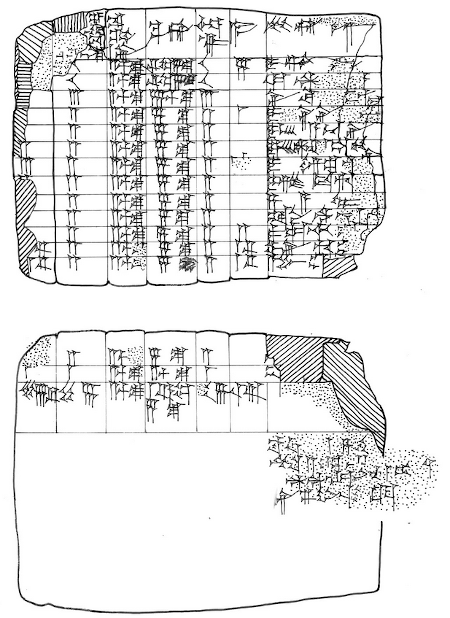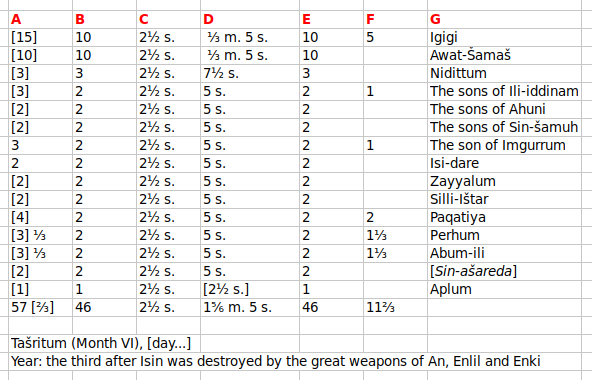
For a full list of BASHing data blog posts see the index page. ![]()
A data table thousands of years old
I knew that data tables had been around a long time, but I didn't appreciate how long until I read recently about account-keeping in ancient Mesopotamia.
The accounts were written on clay tablets, sometimes with impressed lines to mark off rows and columns. Here's a drawing of the front and back sides of an example:

This tablet was found on the site of the old city of Larsa near the mouth of the Euphrates in Iraq. Someone wrote on the tablet in the Old Babylonian Period, ca 3600-4000 years ago.
The cuneiform text was transliterated and translated by Eleanor Robson, who currently heads the History Department at University College London. You can see her efforts at this website by clicking on the tablet's British Museum catalog number, BM 085232.
Below I've put Prof. Robson's translation into a spreadsheet. Items in square brackets are guessed fill-ins. The "s." stands for shekels and "m." is mūšar, equal to 60 shekels.

A = "Troops, available assets"
B = "Those who were sent from Sin's dyke"
C = "Earth, the (daily) work assignment of 1 man"
D = "Its earth"
E = "Check made"
F = "Arrears"
G = "Its name"
It looks to me like a payroll summary from a construction project, but that's a modern-day view. What's clear is that the person who inscribed the clay was organising similar data items neatly in rows and columns (with column headers), and operating on those items in ways familiar to us moderns.
Column A, for example, looks like the sum of columns B (or E) and F. Column C is a base rate of pay, and column D is the base rate multiplied by the quantity in column B (or E). Each non-header row corresponds to a person or persons in column G, except the last row with column totals.
This remarkable record is evidence that data tables (as we understand them) were used for record-keeping more than 3500 years ago. It's tempting to think that civilisation progresses step-wise, and that you could trace the use of data tables in an unbroken path from clay tablets to today's spreadsheets. I don't think that's a realistic view. Inventions get lost or forgotten, then re-invented. What was obvious to that account-keeper in ancient Mesopotamia might not have been obvious at later times and in other places.
I'm pretty confident, though, that in another thousand years there will still be ancient data tables "archived" underground in Iraq, while todays' billions of spreadsheets in digital form and on non-archival paper will have long since disappeared.
Last update: 2020-08-12
The blog posts on this website are licensed under a
Creative Commons Attribution-NonCommercial 4.0 International License